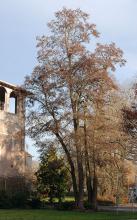Alnus glutinosa
Common name:
Common Alder
European Alder
Black Alder
Pronunciation:
AL-nus glu-ti-NO-sa
Family:
Betulaceae
Genus:
Type:
Broadleaf
Native to (or naturalized in) Oregon:
No
- Broadleaf deciduous tree to 65 ft (20 m) tall or, rarely, more, often multistemmed, open crown. Bark brown-black. Twigs covered with glutinous glands, smooth. Leaves simple, alternate, 4-10 cm long, broad subovate to orbicular, apex rounded, base acuminate, margins coarsely and doubly serrate, dark green above, paler below, petiole 1-2.5 cm. Male (pollen) catkins are in clusters of 3-5, each 5-10 cm long; female (seed) catkins when mature are cone-like, 1-2 cm long, ovoid, long stalked.
- Sun part shade. Apparently not to fussy about soil, tolerates dry soils, but is best in moist or even wet soils.
- Hardy to USDA Zone 4 Native to Europe to the Caucasus and Siberia. A nitrogen fixer. Several cultivars available, including 'Laciniata' and 'Imperialis', both of which have deeply dissected leaves.
-
Caution: Alnus glutinosa is a moderate to serious invasive species of wet sites in USA, maritime Canada, Australia, India, Republic of Korea, and New Zealand. It is widespread in the Great Lakes region and present in18 states.
- glutinosa: sticky, the young leaves and stems
- Oregon State Univ. campus: on short service road leading to Pharmacy and Furman Hall.








